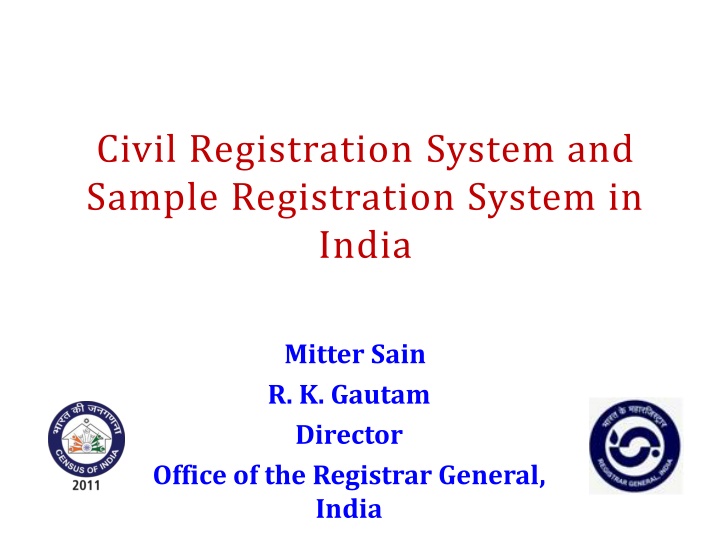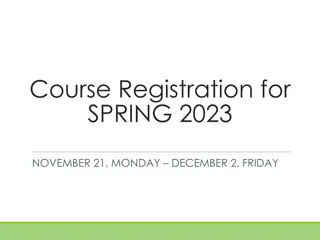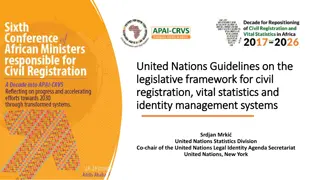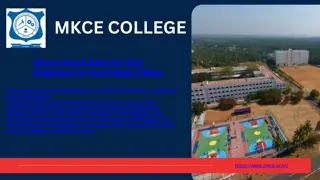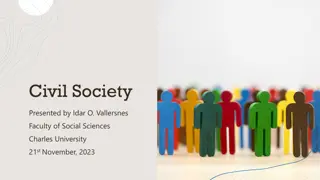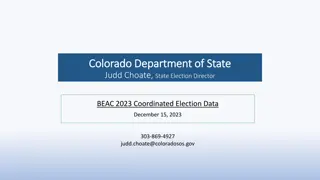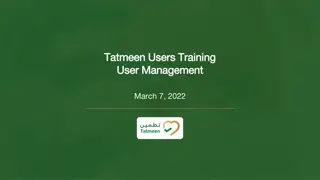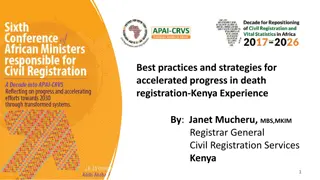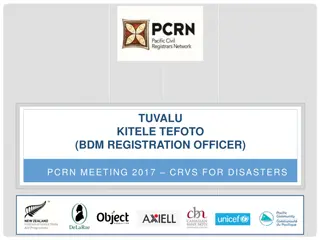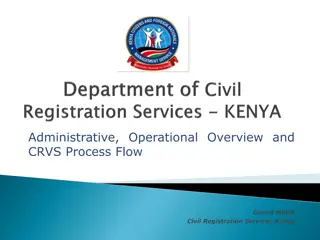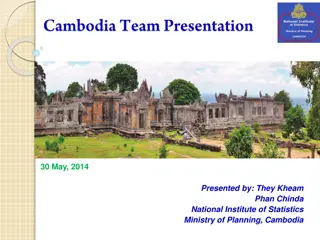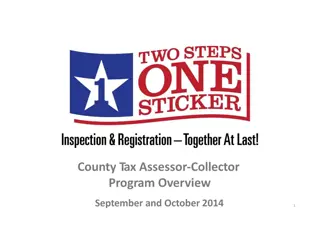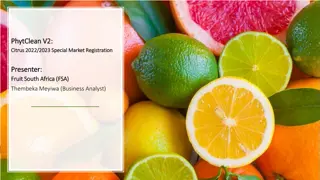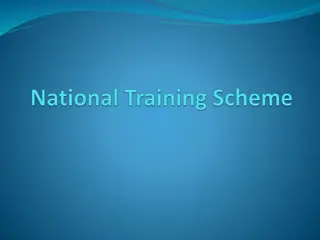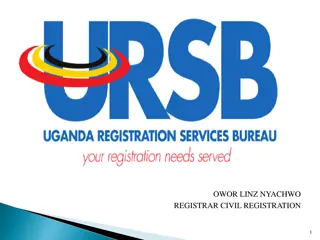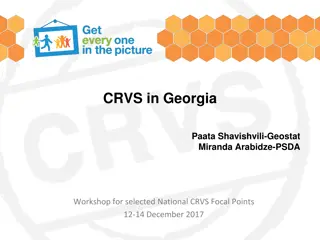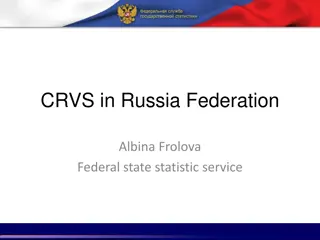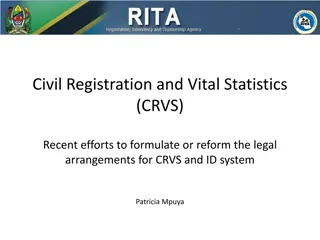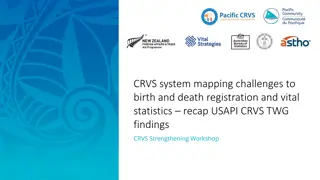Civil Registration System in India - Overview and Challenges
The Civil Registration System in India is based on the Registration of Birth and Death Act of 1969, mandating uniform provisions for birth and death registrations. Despite its importance, challenges such as lack of awareness and coordination exist. Vision 2020 aims for universal civil registration by 2020, aligning with global conventions. New initiatives are being implemented to revitalize the system, linking services with registration and enhancing implementation through collaboration and simplification of processes.
Download Presentation

Please find below an Image/Link to download the presentation.
The content on the website is provided AS IS for your information and personal use only. It may not be sold, licensed, or shared on other websites without obtaining consent from the author.If you encounter any issues during the download, it is possible that the publisher has removed the file from their server.
You are allowed to download the files provided on this website for personal or commercial use, subject to the condition that they are used lawfully. All files are the property of their respective owners.
The content on the website is provided AS IS for your information and personal use only. It may not be sold, licensed, or shared on other websites without obtaining consent from the author.
E N D
Presentation Transcript
Civil Registration System and Sample Registration System in India Mitter Sain R. K. Gautam Director Office of the Registrar General, India
CIVIL REGISTRATION SYSTEM IN INDIA Based on Registration of Birth and Death Act,1969 Provisions are mandatory and uniform throughout the country Implementation is the responsibility of the State Governments through State Rules Provides legal documents to every individual birth /death certificates Generates Vital Statistics e.g. CRS Report, SRS Report, MCCD Report and AHS Report.
Challenges in CRS Lack of awareness to the need and importance of registration. The low priority accorded to the system of civil registration by the States Bottleneck in monitoring the flow of registered vital events. Problems in estimating IMR & MMR due to under reporting of domiciliary infant deaths & still births and misclassification of maternal deaths in better performing States. Utility of data gets diminished on account of delayed reporting by the States. Lack of coordination among the concerned departments. Low level of reporting by registration units. Problems in linking of birth certificates to basic services.
Vision 2020 Our Vision- Universal Civil Registration by 2020 India is signatory to the UN convention of child rights. Article 7 of convention mandates compulsory registration of birth to acquire a nationality 100 Universal Civil Registration is a part of the Development Agenda of UN post 2015 100 UNESCAP has set a vision of universal and registration in Asia and Pacific and has declared the decade 2015-2024 as the Civil Registration Decade responsive civil 4
New Initiatives to re-vitalise the system To enhance the utility, MOHFW has linked the delivery of services with registration e.g. cash incentive under JSY etc. Provision Anganwadi/ASHA for registration and delivery. for incentive to grass-root workers like Registration is one of the focus areas under National Rural Health Mission (NRHM). Provisions of the Act are being simplified for better implementation. Linking CRS at sub-district level to update NPR. Collaboration with various partners for further strengthening of the system.
New Initiatives to re-vitalise the system Implementation of CRS committee recommendations/ Supreme Court directions continuing activity through[Budget provided by NRHM]. Computer hardware were provided to all 671 districts to strengthen the system during 2013-14. Financial assistance provided for Digitization of old birth and death records in all States/UTs Financial Assistance to States/UTs for hiring of manpower up to district level i.e. State coordinators at State level and Data Processing Assistant at district level. Financial assistance for Training & Publicity through IEC activities to the States/UTs. Funds allocated to each DCOs for inspections. Regular inspections by the officers of ORGI in various States. 6
New Initiatives to re-vitalise the system Financial assistance for Training & Publicity through IEC activities to the States/UTs. Funds allocated to each DCOs for inspections. Regular inspections by the officers of ORGI in various States. Training Manual for Civil Registration functionaries in 13 languages. Event Monitoring System for Registration (REMS) for Medical Institutions. Uniform software for online and offline registration of births and deaths and generation of statistical tables. Uniform software will provide real time data to track registration activities and to allow preservation of reporting forms in digital mode 7
New Initiatives to re-vitalise the system Financial assistance for Setting up of Data Entry Centers at Tehsil for computerization of CRS records and linkage with NPR was also provided to 10 States/UTs. DEC to be set up in all the sub-districts of 3 selected States viz. Tamil Nadu, Odisha and West Bengal and all 7 UTs Coordination with Registration functionaries. Data entry of birth and death reporting forms using CRS application for the units without PC. Provision of uploading of offline data to CRS server. Updation of NPR database through CRS. Provision of Biometric enrollment under NPR. 8
Database of Medical Institutions Database of Government and Private hospitals prepared to monitor reporting efficiency of hospitals. SMS based notification of events by Medical Institutions. Auto alerts to non reporting medical institutions. Database of Registrars to monitor reporting and registration efficiency. Expected to compile data up to registration unit level. 9
New Initiatives taken to extend the scope of RBD Act, 1969 Specific guidelines issued for- Registration of births of children taken on adoption; born through Surrogacy/ART/IVF Technique; Registration of deaths of missing persons /of those who died due to natural calamities and disasters 10
Features of Uniform CRS Application Software Uniform Software for Civil Registration It is a online application is ready for implementation, after Pilot testing. It has all features as per the RBD Act, generation of statuary statistical tables at National, State, and district level on real time basis and track registration activities. Also has Offline version for stand alone machine with facility to export data to the central server. Preserves reporting forms in digital mode. 11
CRS Application - Modules Integrated application Built in quick helps for minimal entry Potential for deploying it on multi lingual 12
Monitoring System for Registration of Institutional Events (REMS) Capture summary of Births and Deaths taking place at Medical Institutions on daily basis. Single integrated system for all stake holders Available 24 X 7 online Easy-to-use interface with required security. Generation of Alerts/Reports at Registrar, District Registrar, Chief Registrar and ORGI level. To help in achieving cent per cent registration of events taking place in institutes.
Monitoring System for Registration of Institutional Events (REMS) Single point consolidation of all events reporting across country SMS based notification of events by Medical Institutions. Auto alerts to medical institutions in case of non- compliance Generation of Reports at Registrar, District Registrar, Chief Registrar and ORGI level
REGISTERING INSTITUTES A unique Code will be issued to Institute and Registrar. A standard welcome message via SMS is sent to Institutes as a confirmation on registration with the system. Welcome SMS explains the process of reporting the event along with the SMS format to report Events.
EVENTS MONITORING The Institute report event via SMS. The Registrar registers Institutional event via CRS application. The system matches the events reported by Institutes and Registered Events. The result in every case should be: Events Reported by Institutes = Events Registered by Registrars
ALERTS CASE 1 EVENT NOT REPORTED CASE 2 EVENT REPORTED BUT NOT REGISTERED CASE 3 EVENT REGISTERED BUT NOT REPORTED
